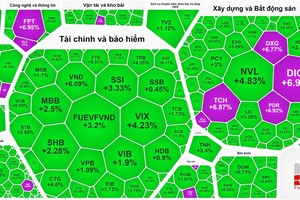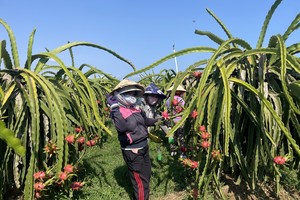
A lack of synchronism
According to statistics, so far, clean power projects that have been added to the national and provincial power development plans operated before 2021 include 187 wind power projects with a capacity of 11,419 MWs and 135 solar power projects with 13,617 MWs. Besides, about 320 solar power projects with 34,000 MWs and 300 wind power projects with 74,000 MWs have been proposed to add to the implementation plan in the period from 2021 to 2023 by investors and localities.
As for liquefied natural gas (LNG) power, up to now, 11 LNG power plant projects have been added to the national power plan, with a total capacity of 16,100-16,400 MWs. These figures show that the development of clean electricity is an inevitable trend. It is in accordance with the spirit of Resolution No.55 of the Politburo on the orientation of energy development of Vietnam, which is to develop clean energy and encourage households to use clean and renewable energy.
Despite positive initial results in investment attraction, the rapid development of clean electricity sources currently faces some barriers.
For example, the latest cases are that many solar and wind power sources have had to reduce power generation due to grid congestion, although Vietnam Electricity (EVN) invested in many power grid projects from 110 kilovolts (kV) to 500 kV with over 750 kilometers of lines and over 5,000 mega-volt-amperes (MVA) of transformer stations to release clean energy over the past time. Many investors of this power source have also invested in the grids that connect the general transmission system by themselves. However, the regulations on the scope of management and asset handover are not clear.
Or the addition of new projects to the plan also encounters difficulties because the new regulations of the Law on Planning and the current ones are not consistent. The procedures for the supplement usually take a very long time. Despite being added to the plan, the grid connection of many projects has not been approved. The incentive mechanisms via price subsidy for solar power expired by the end of 2020, and those for wind power will come to an end in November this year. The contents of power purchase and sale contracts have not yet contained a term in which power buyers share risks with investors, especially private investors.
A transparent investment environment needed
‘The power grid infrastructure remains weak and asynchronous to create a technical basis for the integration of clean power sources. That has caused several difficulties for investors when borrowing money because the efficiency of the projects decreases significantly,’ a representative of a solar power investor analyzed.
According to Professor-Doctor of Science Nguyen Mai, policymakers need to comprehensively reevaluate positive results, as well as existing issues, to build a transparent investment environment to create favorable conditions for the development of clean energy. The “ask-give” mechanism should be limited, and there should be general mechanisms and policies to encourage private investment in power transmission. By doing that, the National Power Development Master Plan 8 can be carried out as the Ministry of Industry and Trade is submitting to the Government. These issues will be resolved if the research, development, and issuance of a specific law on clean energy are prioritized.
Sharing the same point of view, many experts said that the State needs to allow socialization for a part of direct power transmission and distribution. Especially, ministries need to review legal provisions related to investment, planning, construction, land management, and bidding to propose amendments to the gaps and overlaps among the laws. The guide on the implementation of public-private partnership (PPP) investment projects should be provided early so that large-scale independent power projects can be smoothly deployed, as well as risk-sharing in power purchase agreements. Thereby, it will encourage and motivate more resources to invest in developing clean power sources for the future.
According to statistics, so far, clean power projects that have been added to the national and provincial power development plans operated before 2021 include 187 wind power projects with a capacity of 11,419 MWs and 135 solar power projects with 13,617 MWs. Besides, about 320 solar power projects with 34,000 MWs and 300 wind power projects with 74,000 MWs have been proposed to add to the implementation plan in the period from 2021 to 2023 by investors and localities.
As for liquefied natural gas (LNG) power, up to now, 11 LNG power plant projects have been added to the national power plan, with a total capacity of 16,100-16,400 MWs. These figures show that the development of clean electricity is an inevitable trend. It is in accordance with the spirit of Resolution No.55 of the Politburo on the orientation of energy development of Vietnam, which is to develop clean energy and encourage households to use clean and renewable energy.
Despite positive initial results in investment attraction, the rapid development of clean electricity sources currently faces some barriers.
For example, the latest cases are that many solar and wind power sources have had to reduce power generation due to grid congestion, although Vietnam Electricity (EVN) invested in many power grid projects from 110 kilovolts (kV) to 500 kV with over 750 kilometers of lines and over 5,000 mega-volt-amperes (MVA) of transformer stations to release clean energy over the past time. Many investors of this power source have also invested in the grids that connect the general transmission system by themselves. However, the regulations on the scope of management and asset handover are not clear.
Or the addition of new projects to the plan also encounters difficulties because the new regulations of the Law on Planning and the current ones are not consistent. The procedures for the supplement usually take a very long time. Despite being added to the plan, the grid connection of many projects has not been approved. The incentive mechanisms via price subsidy for solar power expired by the end of 2020, and those for wind power will come to an end in November this year. The contents of power purchase and sale contracts have not yet contained a term in which power buyers share risks with investors, especially private investors.
A transparent investment environment needed
‘The power grid infrastructure remains weak and asynchronous to create a technical basis for the integration of clean power sources. That has caused several difficulties for investors when borrowing money because the efficiency of the projects decreases significantly,’ a representative of a solar power investor analyzed.
According to Professor-Doctor of Science Nguyen Mai, policymakers need to comprehensively reevaluate positive results, as well as existing issues, to build a transparent investment environment to create favorable conditions for the development of clean energy. The “ask-give” mechanism should be limited, and there should be general mechanisms and policies to encourage private investment in power transmission. By doing that, the National Power Development Master Plan 8 can be carried out as the Ministry of Industry and Trade is submitting to the Government. These issues will be resolved if the research, development, and issuance of a specific law on clean energy are prioritized.
Sharing the same point of view, many experts said that the State needs to allow socialization for a part of direct power transmission and distribution. Especially, ministries need to review legal provisions related to investment, planning, construction, land management, and bidding to propose amendments to the gaps and overlaps among the laws. The guide on the implementation of public-private partnership (PPP) investment projects should be provided early so that large-scale independent power projects can be smoothly deployed, as well as risk-sharing in power purchase agreements. Thereby, it will encourage and motivate more resources to invest in developing clean power sources for the future.
























